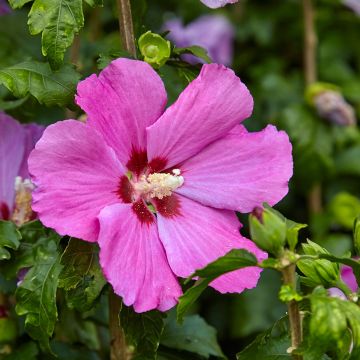

Collection of Phormiums for an exotic bed
Collection of Phormiums for an exotic bed
Phormiums tenax, cookianum Purpureum, Black Adder
New Zealand flax, harakeke, wharariki
Special offer!
Receive a €20 voucher for any order over €90 (excluding delivery costs, credit notes, and plastic-free options)!
1- Add your favorite plants to your cart.
2- Once you have reached €90, confirm your order (you can even choose the delivery date!).
3- As soon as your order is shipped, you will receive an email containing your voucher code, valid for 3 months (90 days).
Your voucher is unique and can only be used once, for any order with a minimum value of €20, excluding delivery costs.
Can be combined with other current offers, non-divisible and non-refundable.
Home or relay delivery (depending on size and destination)
Schedule delivery date,
and select date in basket
This plant carries a 24 months recovery warranty
More information
We guarantee the quality of our plants for a full growing cycle, and will replace at our expense any plant that fails to recover under normal climatic and planting conditions.
Would this plant suit my garden?
Set up your Plantfit profile →
Description
This collection of Phormiums for exotic borders consists of three varieties carefully selected for their ease of cultivation and ornamental qualities. These plants, known as "New Zealand Flax," are distinguished by their evergreen foliage in various colours. These robust perennials are appreciated for their hardiness and low water requirements, although they have limited cold resistance.
Collection details:
x 1 Phormium tenax: a botanical species with upright green leaves, reaching up to 2m in height. Its summer flowering takes the form of a tall spike adorned with reddish flowers.
x 1 Phormium tenax 'Purpureum': this variety develops upright purple leaves, with the plant reaching about 1.5m in height. Its summer flowering is similar to that of Phormium tenax.
x 1 Phormium 'Black Adder': a variety with very dark, almost black foliage, reaching up to 1.2m in height. Its flowers are red or orange.
Plant these Phormiums in spring or autumn to promote good root growth. They thrive in borders, beds, or pots. Place the tallest plants, such as Phormium tenax, at the back of the border. Arrange the 'Black Adder' and 'Purpureum' Phormiums at the front of the border to create a sense of depth. Maintain a spacing of 70cm between each plant to allow for proper development. For a mass effect, plan for 2 to 3 plants per square metre.
Phormiums pair well with plants with similar needs, such as Agapanthus, Cordylines, and tall grasses like Panicum. Beautiful Miscanthus sinensis 'Purpurascens'. Agapanthus, with their blue or white flowers, add a complementary touch of colour and can be placed at the front of the borders. Cordylines, with their habit and architectural foliage, can be mixed with Phormiums to reinforce the exotic effect. Grasses add movement and lightness and should be planted in the background. All these plants will create a harmonious and dynamic border requiring very little maintenance.
Report an error about the product description
Plant habit
Flowering
Foliage
Botanical data
Phormiums
tenax, cookianum
Purpureum, Black Adder
Asphodelaceae
New Zealand flax, harakeke, wharariki
Cultivar or hybrid
Other Phormium
View all →Planting and care
Phormium thrives in the sun in well-drained, rich soil that does not become waterlogged. Once well-rooted, it withstands summer drought fairly well. It can tolerate winds and sea spray, but shelter it from cold north winds. When planting in spring, add compost, coarse sand such as river sand, or gravel. In winter, protect the bush with winter fleece. Phormium can withstand brief frosts of around -8/-10 °C once mature. It does not require any particular pruning. Only remove dried leaves and faded flower stalks. Do not overwater, only in case of drought. This plant has few enemies, as it does not attract predators.
Phormium grows well in a large pot, which allows it to be overwintered in a very bright, unheated but frost-free room.
Planting period
Intended location
Care
This item has not been reviewed yet - be the first to leave a review about it.
Similar products
Haven't found what you were looking for?
Hardiness is the lowest winter temperature a plant can endure without suffering serious damage or even dying. However, hardiness is affected by location (a sheltered area, such as a patio), protection (winter cover) and soil type (hardiness is improved by well-drained soil).

Photo Sharing Terms & Conditions
In order to encourage gardeners to interact and share their experiences, Promesse de fleurs offers various media enabling content to be uploaded onto its Site - in particular via the ‘Photo sharing’ module.
The User agrees to refrain from:
- Posting any content that is illegal, prejudicial, insulting, racist, inciteful to hatred, revisionist, contrary to public decency, that infringes on privacy or on the privacy rights of third parties, in particular the publicity rights of persons and goods, intellectual property rights, or the right to privacy.
- Submitting content on behalf of a third party;
- Impersonate the identity of a third party and/or publish any personal information about a third party;
In general, the User undertakes to refrain from any unethical behaviour.
All Content (in particular text, comments, files, images, photos, videos, creative works, etc.), which may be subject to property or intellectual property rights, image or other private rights, shall remain the property of the User, subject to the limited rights granted by the terms of the licence granted by Promesse de fleurs as stated below. Users are at liberty to publish or not to publish such Content on the Site, notably via the ‘Photo Sharing’ facility, and accept that this Content shall be made public and freely accessible, notably on the Internet.
Users further acknowledge, undertake to have ,and guarantee that they hold all necessary rights and permissions to publish such material on the Site, in particular with regard to the legislation in force pertaining to any privacy, property, intellectual property, image, or contractual rights, or rights of any other nature. By publishing such Content on the Site, Users acknowledge accepting full liability as publishers of the Content within the meaning of the law, and grant Promesse de fleurs, free of charge, an inclusive, worldwide licence for the said Content for the entire duration of its publication, including all reproduction, representation, up/downloading, displaying, performing, transmission, and storage rights.
Users also grant permission for their name to be linked to the Content and accept that this link may not always be made available.
By engaging in posting material, Users consent to their Content becoming automatically accessible on the Internet, in particular on other sites and/or blogs and/or web pages of the Promesse de fleurs site, including in particular social pages and the Promesse de fleurs catalogue.
Users may secure the removal of entrusted content free of charge by issuing a simple request via our contact form.
The flowering period indicated on our website applies to countries and regions located in USDA zone 8 (France, the United Kingdom, Ireland, the Netherlands, etc.)
It will vary according to where you live:
- In zones 9 to 10 (Italy, Spain, Greece, etc.), flowering will occur about 2 to 4 weeks earlier.
- In zones 6 to 7 (Germany, Poland, Slovenia, and lower mountainous regions), flowering will be delayed by 2 to 3 weeks.
- In zone 5 (Central Europe, Scandinavia), blooming will be delayed by 3 to 5 weeks.
In temperate climates, pruning of spring-flowering shrubs (forsythia, spireas, etc.) should be done just after flowering.
Pruning of summer-flowering shrubs (Indian Lilac, Perovskia, etc.) can be done in winter or spring.
In cold regions as well as with frost-sensitive plants, avoid pruning too early when severe frosts may still occur.
The planting period indicated on our website applies to countries and regions located in USDA zone 8 (France, United Kingdom, Ireland, Netherlands).
It will vary according to where you live:
- In Mediterranean zones (Marseille, Madrid, Milan, etc.), autumn and winter are the best planting periods.
- In continental zones (Strasbourg, Munich, Vienna, etc.), delay planting by 2 to 3 weeks in spring and bring it forward by 2 to 4 weeks in autumn.
- In mountainous regions (the Alps, Pyrenees, Carpathians, etc.), it is best to plant in late spring (May-June) or late summer (August-September).
The harvesting period indicated on our website applies to countries and regions in USDA zone 8 (France, England, Ireland, the Netherlands).
In colder areas (Scandinavia, Poland, Austria...) fruit and vegetable harvests are likely to be delayed by 3-4 weeks.
In warmer areas (Italy, Spain, Greece, etc.), harvesting will probably take place earlier, depending on weather conditions.
The sowing periods indicated on our website apply to countries and regions within USDA Zone 8 (France, UK, Ireland, Netherlands).
In colder areas (Scandinavia, Poland, Austria...), delay any outdoor sowing by 3-4 weeks, or sow under glass.
In warmer climes (Italy, Spain, Greece, etc.), bring outdoor sowing forward by a few weeks.


















































